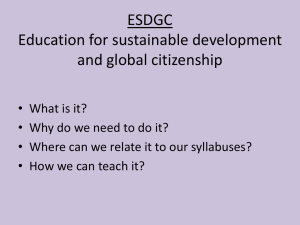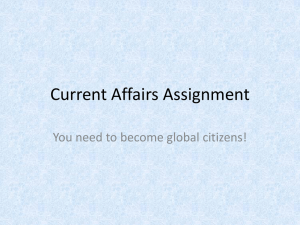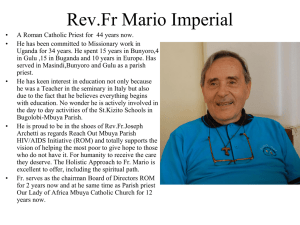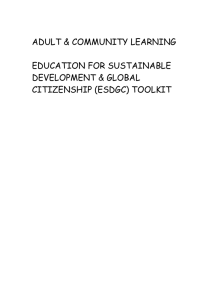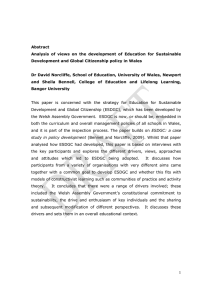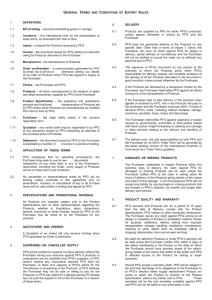CWC School Linking 2
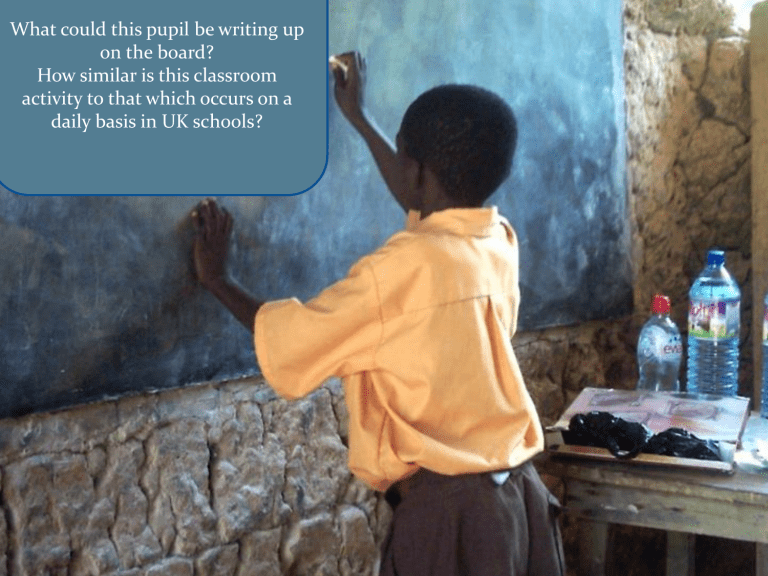
What could this pupil be writing up on the board?
How similar is this classroom activity to that which occurs on a daily basis in UK schools?
Alison Leonard, doctoral student:
Development Education Research Centre,
Institute of Education,
University of London
School linking: young people’s perspectives from the Global South
DfID claims “Over 3,900 partnerships have been established (November
2011)” since its Global
Schools Partnerships
(DGSP) linking programme started in
2003
DGSP is being replaced with a new programme
The location of Southern schools in DfID’s new
“Connecting Classrooms” linking programme is focused on African and
South Asian locations
Young people and School links
My key questions today:
1.
How does the S/NELP affect young people in the global
South?
2. How do young people learn about ESDGC and
Development Education?
3. What advice do young people offer to those contemplating new links?
My data today:
•
•
•
•
• From focus groups with students in Ghana, Uganda and Tanzania
In Ghana: girls at a rural secondary school
In Uganda: students in a primary school and a secondary school
In Tanzania: students in a
Zanzibar secondary school
+ occasionally comments from their teachers
1. How the South/North Educational
Linking Process (S/NELP) affects young people
Friendships
Aspirations
Educational attainment
Resourcing of education
1. How the S/NELP affects young people in the global South
Friendships: SJCC
E There is cooperation between the children in Uganda and the children in UK, development . (SJCC PFG 13-14)
E If there is cooperation I mean there is friendship, cooperative- we cooperate to each other. (SJCC PFG 15-
16)
1. How the S/NELP affects young people in the global South
Aspirations
“I think this partnership is also helping to get more girls or more of us interested in schooling…”
“I think the partnership is also helping, because, um, when the students from Weald come to
Ghana, and the pupils there in our school sees them, we admire them because.. We wouldn’t...
I’m not too sure that any of the students from
Krobo Girls would want to end up in the streets or selling something, when we see the Weald students come: the way they talk, the, the way they present themselves generally, the way they are able to express themselves the student there are in my school are also motivated to do the same things. So they wouldn’t really want to drop out of school.” (P, PFG)
“But with these girl child education advocates all over the place and with this ...project most students, most girls, or most parents now understand the relevance of education and its helping to promote … gender equality and empowering women”.
1. How the S/NELP affects young people in the global South
Educational attainment
Our teachers have benefited from various teachers, including there is a lot of teachers who have visits to there. Europe, I mean London, so they are among the people who are going to visit London, are our teachers. So, that is very important for our teachers, because when they go there they study something about it and when they came here they maybe they modify. How, how this is, maybe? This is very important, this is [hard] for me maybe, this teaching is very important. So, they know what I am going to teach and what I am not. (S, PFG, 161-168)
Teachers from Aston school and
Makunduchi school, they are creating a relationship, because in our school there are few teachers of science. And, from this situation, it helped us to get, to get another teacher of science, because in this school teachers of science is: few. And in this situation it helped us to improve the knowledge, especially science, because it is very important knowledge. (M, PFG, 188-
193)
1. How the S/NELP affects young people in the global South
Resourcing of education
1. How the S/NELP affects young people in the global South
2. How young people learn about
ESDGC
Education for Sustainable
Development (ESD)
Collaborative learning
Project work
Critical Global Citizenship
(GC)
Science investigations
2. How do young people learn about ESDGC and Development Education?
2. How young people learn about
ESDGC
Project work Science investigation
With this link, with the group from Weald of Kent have encouraged us to recycle our rubbish, because really the rubbish are posing a great challenge and problem in
Ghana. Therefore with their encouragement we’ve been able to use this rubbish to make a carpet and floormats, which was presented to the Weald of Kent school.
2. How do young people learn about ESDGC and Development Education?
2. How young people learn about
Development Education
Development education: Contact through visits
Promotes and supports education for world citizenship
Encourages people to consider the world through the eyes and ears of others
Promotes the voices and viewpoints of those who are excluded from an equal share in the benefits of human development internationally
Experiences and actions within development education
...a set of experiences that create interest and engagement...
Irish Aid (2006)
2. How young people learn about
Development Education
Development Education
From a male Ugandan primary school pupil
Social injustice: Since some of the children who are unable to pay their school fees through their parents, they are given care and school fees from the links from
Europe. They are given money to avoid illiteracy, in the school in
Uganda and all over parts of the nation.
It is good through the links because many of the schools have been improved, have been modernised and illiteracy has been prevented and avoided.
2. How do young people learn about ESDGC and Development Education?
The world through the eyes and ears of others
Stereotypes Reality: critical GCE
S Since Stephen Jota is supporting orphans in Uganda, so those children in UK help in supporting some children in Uganda, like orphans and other disabled people (SJCC PFG 21-22)
So, they teach us maybe theory, but we need practical. I mean maybe when you finds maybe practical… Sodium reacts with, maybe magnesium; sodium reacts with water, so that: what happened? So, that fact you are supposed to have seen, by face. So, you see, to a lot of schools, within Africa, including Makunduchi, there is less laboratory apparatus. So, this is a very, very difficult problem for our schools.
(S, PFG, 219-224)
2. How do young people learn about ESDGC and Development Education?
2. How do young people learn about ESDGC and Development Education?
Contributions to the UN’s final MDG, a
Partnership for Global Development
Through partnerships many of these things have been developed; some of our countries… Some of our countries who hadn’t had markets, they have improved markets through those regional bodies. That will help the development in the global partnership, of their country.
They will create markets, free market movement of goods, there will be employed; many will get chances of movementmany will get chances of taking their goods abroad- and bringing say? There will be a spreading of possibility of importing and exporting; there will be free movement of goods. They will reduce taxes; highly paid taxes will be reduced. That is what I have.
2. How do young people learn about ESDGC and Development Education?
3. Young people’s advice to those contemplating new links
Advice to new linkers: From secondary students
We learnt um that they used, that they tend to use phones a lot with their host families. So when we are coming we were told that we should be very, very careful as to how we make certain demands. Because the host families might not tell us in the face that, that this is not right, but they might give complaints and then maybe later on then this, due to the complaints, the partnership and the link and everything might end. Because we wouldn’t get people who would want to host us anymore. So we are very, very careful.
3. Young people’s advice about new links
3. Young people and new links
Primary to secondary: Primary school advice
S To me, I would advise that the schools, if they have a link they should be with a goal, that they are aiming to, and they should avoid corruption in what they are doing and they should be satisfied with what they are given and in order to achieve what they are getting at. (S, PFG,157-160)
3. Young people’s advice about new links
Funding School links
2012 and beyond…
Funding for Development,
Development Education and charitable giving is likely to face renewed pressure in 2012
“We can maybe take the beads there, exhibit it and then sell. To maybe, maybe we have a programme down, projects down here and maybe we are building a school, a library or something, which will facilitate learning or enhance it. Then when we would bring the money down we would use to maybe finish up where we are starting, which would help the students in a very long way” (P, PFG)
Avoiding ‘development pornography’:
The implications are clear: ‘Each image depicting poverty and disease needs to be more graphic than the next to elicit more response’ (Sankore, 2006, p36). Local communities in Canada and the United States respond to these campaigns by creating even more agencies to address humanitarian needs in Africa. The creation of more aid and development agencies leads to frenzied activity among NGOs, who vie to be the best in penetrating the hearts of potential givers. Such competition engenders the production of even more powerful
‘development pornography’ (Ibid p37).
(Quist-Adade and Van Wyk, 2007, p78)
3. Young people’s advice about new links
Misunderstanding, breakdown in communication
Who takes part in Visits?
Dependency
Negative or complicated, complex effects?
Cost effectiveness of projects
Is new expertise increasing local inequalities?
Maintenance, repair, to support use of equipment.
Electricity outages
Cultural clashes – whose values?
Outdated or outmoded technology transfers?
References
Ash, C and Severs, P. (2004), “Do you ask a hungry man if he wants food?”, School Science Review, 86, pp43-47
Bourn, D. and Bain, M. (2011) Impact of School Linking on the Global South- Case Study of Uganda, London, Link Community
Development/Institute of Education
Burr, M. (2007) Thinking about Linking. DEA thinkpiece. www.dea.org.uk/thinkpieces
Burr, M, Andreotti, V and de Souza, L. M. (January 2007): Humanities Education Centre (London): Southern Voices in linking: barriers to engagement
Edge, K., Frayman, K., and Lawrie, J. (2009) ‘The Influence of North-South School Partnerships: Examining the evidence from schools in the
UK, Africa and Asia’. London: Institute of Education
Irish Aid (2006) Irish aid and development education, describing… understanding… challenging, Dublin: Department of Foreign Affairs.
Leonard, A. (2012) A Southern Perspective on The South/North Educational Linking process (S/NELP). Early stage analysis from Zanzibar.
Copies available upon request from the author. Downloadable pdf from www.leonard-morrison.org/Alison_Leonard
McNicholl, K. (2012) Do students benefit from North South School Partnerships?, unpublished MA dissertation, Master of Arts Degree in
Development and Emergency Practice, Oxford Brookes University, Centre for Development and Emergency Practice (CENDEP) School of
Built Environment
Martin, F (2007) ‘School Linking as a Controversial Issue’ in Claire & Holden (eds) The challenge of teaching controversial issues Trentham
Books
Martin, F. (2009) Children's Voices and Global School Partnerships, GTE presentation, http://www.geography.org.uk/gtip/gteconferences/gteconference09
Pickering. S (2008):“What do children really learn? A discussion to investigate the effect that School partnerships have on children’s understanding, sense of values and perceptions of a distant place”, GeogEd Volume 2, Issue 1 Article 3 www.geography.org.uk/geoged
Quist-Adade, C. and Van Wyk, A. (2007) The Role of NGOs in Canada and the USA in the Transformation of the Socio-Cultural Structures in
Africa, Africa Development, Vol. XXXII, No. 2, 2007, pp. 66–96, Council for the Development of Social Science Research in Africa
Scoffham S (2007) Please Miss, Why are they so Poor? Primary Geographer Spring 2007
Thanks to those at:
Kisiki College, Namatumba, Uganda
Krobo Girls Senior Secondary School, Odumase-
Krobo, Ghana
Makunduchi Secondary School, Makunduchi,
Zanzibar, Tanzania
Nakigo Senior Secondary School, Iganga, Uganda
Stephen Jota Children’s Centre, Kampala, Uganda

